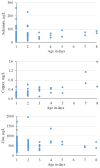Serum concentrations of selenium, copper, and zinc in neonatal foals: Influence of failure of passive transfer and age-related changes
- PMID: 38694739
- PMCID: PMC11017931
Serum concentrations of selenium, copper, and zinc in neonatal foals: Influence of failure of passive transfer and age-related changes
Abstract
Background: An adequate supply of trace elements is very important for equine neonates, as deficiencies can lead to health problems and even death.
Objective: This study investigated serum concentrations of selenium (Se), copper (Cu), and zinc (Zn) in neonatal foals up to the 8th day of life. The influences of disease, age, and failure of passive transfer (FPT) on these concentrations were analyzed.
Animals and procedure: Serum concentrations of Se, Cu, and Zn were determined from blood samples of 93 foals by means of inductively coupled plasma mass spectrometry. The foals were divided into 2 groups based on health status: clinically sick (n = 51) and clinically healthy (n = 42). The latter group was further divided into foals with FPT (n = 20) and those without (n = 22).
Results: Mean serum concentrations for Se, Cu, and Zn were 60 ± 40 μg/L, 0.25 ± 0.22 mg/L, and 605 ± 285 μg/L, respectively. A significant influence of age on serum Cu concentration was observed (P < 0.0001). No differences were observed between any of the serum concentrations in clinically sick and clinically healthy foals on the 1st day of life. The FPT status was not associated with reduced serum concentrations of Se, Cu, or Zn.
Conclusion and clinical relevance: It is not necessary to supplement trace elements in all foals with FPT.
Concentrations sériques de sélénium, de cuivre et de zinc chez les poulains nouveau-nés : influence de l'échec du transfert passif et des changements liés à l'âge.
Contexte: Un apport suffisant en oligo-éléments est très important pour les nouveau-nés équins, car des carences peuvent entraîner des problèmes de santé, voire la mort.
Objectif: Cette étude a examiné les concentrations sériques de sélénium (Se), de cuivre (Cu) et de zinc (Zn) chez les poulains nouveau-nés jusqu’au 8ème jour de vie. Les influences de maladies, de l’âge et de l’échec du transfert passif (FPT) sur ces concentrations ont été analysées.
Animaux et procédure: Les concentrations sériques de Se, Cu et Zn ont été déterminées à partir d’échantillons de sang de 93 poulains au moyen d’une spectrométrie de masse à plasma à couplage inductif. Les poulains ont été divisés en 2 groupes en fonction de leur état de santé: cliniquement malades (n = 51) et cliniquement sains (n = 42). Ce dernier groupe a été divisé en poulains avec FPT (n = 20) et ceux sans (n = 22).
Résultats: Les concentrations sériques moyennes de Se, Cu et Zn étaient respectivement de 60 ± 40 μg/L, 0,25 ± 0,22 mg/L et 605 ± 285 μg/L. Une influence significative de l’âge sur la concentration sérique de Cu a été observée (P < 0,0001). Aucune différence n’a été observée entre les concentrations sériques chez les poulains cliniquement malades et cliniquement sains au premier jour de leur vie. Le statut FPT n’était pas associé à une réduction des concentrations sériques de Se, Cu ou Zn.
Conclusion et pertinence clinique: Il n’est pas nécessaire de supplémenter tous les poulains en oligo-éléments avec FPT.(Traduit par Dr Serge Messier).
Copyright and/or publishing rights held by the Canadian Veterinary Medical Association.
Figures



Similar articles
-
Serum trace elements during treatment in pancreatic cancer patients and their associations with cancer prognosis.Clin Nutr. 2024 Jun;43(6):1459-1472. doi: 10.1016/j.clnu.2024.04.012. Epub 2024 Apr 12. Clin Nutr. 2024. PMID: 38714150
-
Late gestation maternal overnutrition alters gene expression and histomorphology in neonatal foal testes.J Anim Sci. 2025 Jan 4;103:skaf060. doi: 10.1093/jas/skaf060. J Anim Sci. 2025. PMID: 40036360
-
Calcium supplementation commencing before or early in pregnancy, or food fortification with calcium, for preventing hypertensive disorders of pregnancy.Cochrane Database Syst Rev. 2017 Sep 26;9(9):CD011192. doi: 10.1002/14651858.CD011192.pub2. Cochrane Database Syst Rev. 2017. Update in: Cochrane Database Syst Rev. 2019 Sep 16;9:CD011192. doi: 10.1002/14651858.CD011192.pub3. PMID: 28949421 Free PMC article. Updated.
-
Effects of maternal Cu, Mn, and Zn supplementation from different sources on physiological and productive responses of cows and their offspring.J Anim Sci. 2025 Jan 4;103:skae391. doi: 10.1093/jas/skae391. J Anim Sci. 2025. PMID: 39742412
-
Assessment of trace elements in critically ill patients with systemic inflammatory response syndrome: A systematic review.J Trace Elem Med Biol. 2023 Jul;78:127155. doi: 10.1016/j.jtemb.2023.127155. Epub 2023 Mar 15. J Trace Elem Med Biol. 2023. PMID: 36948044
Cited by
-
Serum selenium concentrations in neonatal calves: Influence of postnatal selenium injection and health status.Can Vet J. 2024 Oct;65(10):1041-1047. Can Vet J. 2024. PMID: 39355699 Free PMC article.
References
-
- Valberg SJ, Spier JJ, Parish SM, Murphy M, Carlson GP. Diseases of muscle. In: Smith BP, Van Metre DC, Pusterla N, editors. Large Animal Internal Medicine. 6th ed. St. Louis, Missouri: Mosby; 2020. pp. 1421–1455.
-
- Engelking LR. Vitamins and trace elements. In: Engelking LR, editor. Textbook of Veterinary Physiological Chemistry. 3rd ed. Boston, Massachusetts: Academic Press; 2015. pp. 253–329.
-
- Suttle N. Selenium. In: Suttle N, editor. Mineral Nutrition of Livestock. 5th ed. Oxford, England: CAB International; 2022. pp. 372–411.
-
- Zentek J, Hebeler D, Tiegs W, Meyer H. Se concentrations in liver, kidney and muscle of fetal and newborn foals. Pferdeheilkunde. 1996;12:184–188.
-
- Hall JO. Selenium. In: Gupta RC, editor. Veterinary Toxicology. 3rd ed. San Diego, California: Academic Press; 2018. pp. 469–477.
MeSH terms
Substances
LinkOut - more resources
Full Text Sources
